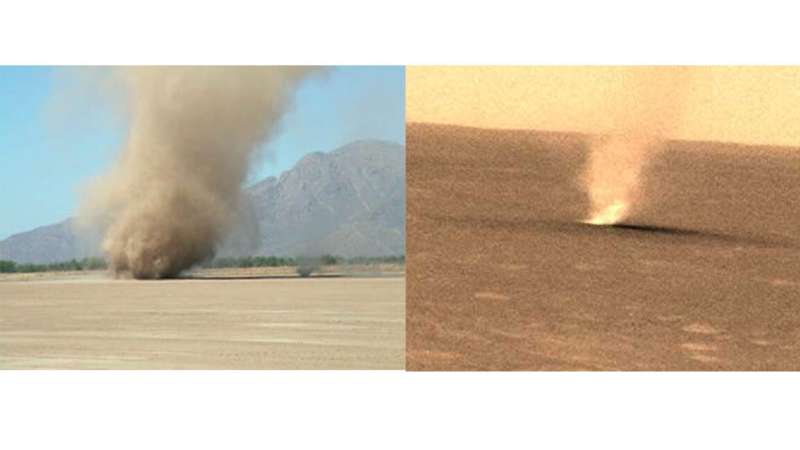Martian dust devil analogues in the Mojave Desert

In the Mojave Desert, the sun beats down on the ground and makes pockets of low pressure. Cool air rushes into these areas, where it warms and rises, creating vortices that pick up dust. These types of dust devils aren't limited to Earth: They are found on Mars at sizes reaching 1,600 meters in diameter.
Dust devils could play a large role in the Martian climate, and they are crucial to understand during missions to the red planet. Louis Urtecho of NASA JPL and the California Institute of Technology described efforts to identify the vortices using data from the Mojave Desert in his presentation, "Automated detection of dust-devil-induced pressure signatures."
The talk took place Dec. 7 at the 183rd Meeting of the Acoustical Society of America.
"The abundance of dust devils on Mars could have implications for the lifetimes of many missions. In fact, dust devils have already played a role in past missions," said Urtecho. "Opportunity and Spirit rovers' lives were extended because friendly dust devils blew dust off their solar panels. But Opportunity eventually succumbed to a global dust storm on Mars, showing the importance of dust loading in the atmosphere."
It is difficult to find and study dust devils on Mars, so Urtecho and his team hope to study them on Earth, then extend the analysis to scale for the different atmosphere. Based on microbarometer data from the Mojave Desert, they built an algorithm to look for the pressure activity indicative of a dust devil. The vortices have a distinct drop in pressure near their centers, and their pressure fluctuates to look like an electrocardiogram (EKG) signal over time.
"The hope is that with our dust devil detector we will be able to learn more about the formation characteristics of convective vortices and how they move across various landscapes," said Urtecho. "This will improve the accuracy of Martian weather models, which has a direct impact not only in understanding dust cycles on Mars and the role they have played in its evolution, but also the operation of future robotic and possibly crewed missions."
More information: Conference: acousticalsociety.org/asa-meetings/
Provided by Acoustical Society of America





















